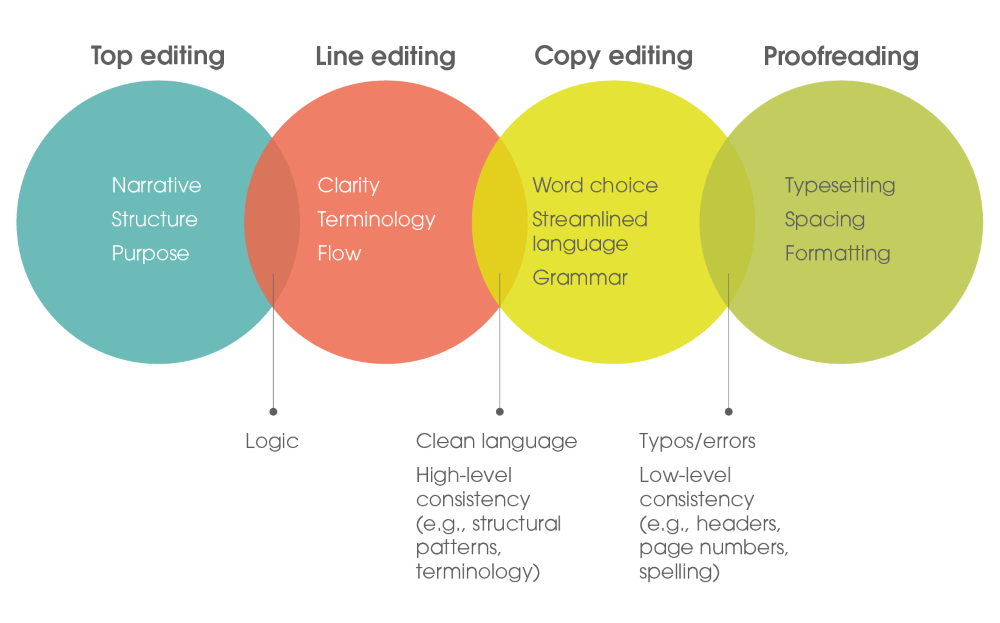Copy editing is an often-misunderstood science. Some writers believe it undoes the work they have put in or adds more work to the process. Others see it as a necessary evil to tick all the boxes before getting content published. At Leff, our team of copy editors has its own idea of what this crucial editorial step is—and we’re here to burst some bubbles about copy-editing misconceptions.
False: Top editing, line editing, copy editing, and proofreading are all basically the same thing
Copy editing is one step in a layered editorial process.
There’s a kind of Venn diagram chain that links top editing, line editing, copy editing, and proofreading—with each set sharing certain elements.
 Often when clients request a copy edit on an article, what they really mean (or what they really need) is an edit for logic or narrative flow. As both deal with the substance of a piece of content, these edits can occur in either top or line editing.
Often when clients request a copy edit on an article, what they really mean (or what they really need) is an edit for logic or narrative flow. As both deal with the substance of a piece of content, these edits can occur in either top or line editing.
What usually follows that kind of development is language cleanup: nailing down and fine-tuning the terminology, ensuring each sentence flows logically from one to the next, and shaping internal consistency. This can happen during line editing and again in copy editing. We take care to use separate editors for line and copy editing to provide a fresh, objective perspective—which can be crucial when a single piece undergoes multiple iterations.
The near-final copy then goes through a rigorous scan to correct typos and inconsistencies, tighten language, and flag sneaky discrepancies—all to enhance a piece from being merely understandable to enjoyable to read. This step takes place in copy editing.
Proofreading follows and focuses on fixing typos and ensuring the piece adheres to the appropriate style guide. It also provides a layer of quality assurance during the design and typesetting process, requiring an entirely different mind-set and a brand–new pair of eyes.
False: Copy editing is the last step before publishing a piece of content
Since editorial development is an iterative process, a single piece of content will undergo two to three stages: narrative development (structure, substance, logic), editorial production (copy editing, fact-checking, proofreading), and often design production (creating a PDF or print document). Often, copy editing is the first step in the middle stage. It usually requires a back-and-forth with the author to sort out anything that was unclear or lacking.
False: Copy editing looks the same across content types, industries, and projects
Depending on the country of audience, specific subject, and, of course, the publication itself, the copy editor may approach the same draft with completely different mind-sets. Even physical medium is a factor, as books, news articles, white papers, and blogs all have their own ways of disseminating information. For instance, news must report the most essential information first, with accessible and impartial language, whereas thought leadership has more leeway to develop a stimulating narrative with narrower industry vernacular. Therefore, a copy editor will need to ensure that a piece written for the energy sector about finances speaks in energy terms, not financial ones.
What’s more, copy editors have to consider the style of the language and copy. Different regions can have divergent lexicons and spelling conventions—even those that speak the same language. Finally, almost every publication has its own style guide or at least adheres to one of the big guys: Chicago Manual of Style for the general public, Associated Press for journalism, or APA (American Psychological Association) for scholarly content. Therefore, the same piece will have subtle differences depending on which style it adheres to, even if the substance is similar.
False: Copy editing can be done by anyone
Anyone who has a good command of the language they’re writing in can spot misspellings or awkward phrases, yes. But the intricacies of lexicon, syntax, and—yes—even punctuation are not as subjective as they may seem. Indeed, many people who work in copy editing have meticulously studied the minutiae of their language to understand how best to frame a point.
At Leff, we hold regular “copy squad” meetings to discuss frequently encountered aspects of copy editing and thorny issues, as well as to establish best practices. We ask the tough questions: Does hyphenating this term change the meaning of the sentence, or does it create confusion? How do we make sure every claim is properly identified in the sources? Which terms are sensitive, and how can we adjust to retain both meaning and the author’s voice?
***
Copy editing is a critical stage in the development of any piece of content. Arguing semantics is a valuable step in the writing process, not only because it makes a piece of content easy or exciting to read but also because it helps identify and patch the holes. Every edit has its purpose and helps create a compelling and clear piece of content.




Leave a Reply
You must be logged in to post a comment.